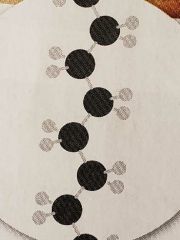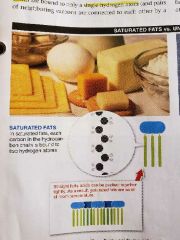![]()
![]()
![]()
Use LEFT and RIGHT arrow keys to navigate between flashcards;
Use UP and DOWN arrow keys to flip the card;
H to show hint;
A reads text to speech;
58 Cards in this Set
- Front
- Back
- 3rd side (hint)
|
Describe Macromolecules |
Large organic molecules made from smaller subunits macromolecules are essential to the building and functioning of organisms. |
|
|
|
Four types of macromolecule that are essential to the building and functioning of organisms are.. |
Carbohydrates, lipids, proteins, and nucleic acids. |
|
|
|
True or false? Carbohydrates are the primary fuel for organisms and also for much of cell structure. |
True |
|
|
|
Carbohydrates contain what three elements? |
Carbon, hydrogen, and oxygen. |
|
|
|
Complete the sentence: As the chemical bonds of carbohydrates are broken down and other, more stable bonds are formed,_______ |
⚡Energy is released that can be used by the organism. |
|
|
|
The most important carbohydrate to organisms is___________
*Give 3 reasons for it's importance. |
-Glucose
-It can be used as an energy source, stored as glycogen for later use, or converted to fat |
|
|
|
True or false? Simple carbs like starch and glycogen CANNOT be linked into complex carbs. |
False... (Can be linked) |
|
|
|
What complex carb cannot be digested by most animals? |
Cellulose🌱 |
|
|
|
True or false? Lipids are insoluble in water and greasy to the touch |
True |
|
|
|
Give three reasons why lipids are valuable to organisms. |
1. Long-term energy storage and insulation 2. In membrane formation 3. As hormones |
|
|
|
_____ are lipids with long hydrocarbon tails they store energy and the many carbon-hydrogen and carbon-carbon bonds. |
Fats |
|
|
|
______ ______ increase the risk of heart disease. |
Trans fats |
|
|
|
What two lipids are important components of cell membranes? |
1. Cholesterol 2. Phospholipids |
|
|
|
Unique combinations of______ amino acids give rise to proteins, the chief building blocks of organisms'_______ structures. |
-20 -physical |
|
|
|
Cholesterol serves as a precursor to.... |
Steroid hormones |
|
|
|
Proteins perform many functions including assisting _____ reactions. |
Chemical |
|
|
|
_______ amino acids make up all the proteins that are necessary for _____, _____,____________. |
1. 20 2. Growth, repair, and replacement if tissue in living organisms. |
|
|
|
True or False? Essential amino acids can be synthesized by humans and other animals, it must be consumed in the diet |
False: cannot be synthesized |
|
|
|
Macromolecule a large molecule made up of smaller building blocks The four types of biological macromolecules are: |
Carbs, lipids, proteins and nucleic acids. |
|
|
|
Which macromolecule: **Is the primary fuel for cells **Forms much of the structure of cells in all organisms? |
A. Lipid B. Carbohydrates C. Proteins D. Nucleic acids |
Carbohydrates |
|
|
True or false?
Carbohydrates (sometimes/never/always) contain carbon, hydrogen, and oxygen |
A. Sometimes B. Never C. Always D. I don't know |
Always |
|
|
1.Glucose and fructose are common monosaccharides that (do/do not) function well as fuel. 2.Why? |
**1. A.Do B.Do Not C.I don't know **2. A. Because of their many carbon hydrogen bonds that break down and release a great deal of energy that organisms can use. B. Because of their simple form that does not need to break down and can simply pass it's through the blood stream. C. Because they are junk food and junk food is not a stable form of fuel or energy |
A.do A. Because of their many carbon hydrogen bonds... |
|
|
True or false : Circulating glucose in the blood stream is called "blood sugar" |
A. True B. False |
True |
|
|
Glucose is the most (unhealthy/important/unimportant) carbohydrates for living organisms |
A. Unhealthy B. Important C. Unimportant |
B. |
|
|
What are the three fates of glucose in the bloodstream? |
🍬It can be used as an energy source 🍬It can be stored as glycogen in the muscles and liver for later use 🍬It can be converted to fat. |
|
|
|
Disaccharides are formed by the union of: **Give an example*" |
Two simple sugars sucrose (table sugar) is an example |
|
|
|
(polysaccharides) Complex carbohydrates are formed by the union of:
**Give example; include the organism that use this as energy storage** |
Many simple sugars
Example: Starch; plants primary form of energy storage |
|
|
|
Explain short-term versus long-term energy |
Simple sugars and complex carbohydrates differ in the way they make energy available to you.Depending on their structure, dietary carbs can lead to Quick but brief or slow but persistent increase in blood sugar. |
|
|
|
Is "fiber" a type of cellulose that humans can digest? What importance is it to our health? |
Fiber is a digestible form of cellular, fiber reduces the risk of colon cancer and other diseases while too much can lead to diarrhea. |
|
|
|
True or false? Lipids in your diet have more energy rich carbon-hydrogen bonds than do carbs: contain more stored energy |
True |
|
|
|
Describe three typical features of lipids |
-nonpolar molecules that do not dissolve in water -greasy to the touch -a source of energy storage |
|
|
|
Give three types of lipids and briefly describe the function of each |
1. Fats: long-term energy storage and insulation 2. Sterols: Regulate growth and development (hormones) 3. Phospholipids: cell membrane formation |
|
|
|
Triglycerides At solid room temperature are called___ At liquid at room temperature are called___ |
Fats; oils |
|
|

If each carbon atom in a hydrocarbon chain of fatty acid is bonded to two hydrogen atoms, the fat molecule carries the maximum number of hydrogen atoms and is said to be a____ |

Saturated fat |
|
|

When some of the carbon atoms are bound to only single hydrogen atom, they are said to be________
|
Unsaturated fat |
|
|
|
The hydrogenation of oil means that hydrogen atoms have been (added/removed) to a liquid saturated fat so that it becomes more saturated, making it less helpful because it also_______fats |
**added **Trans fats |
|
|
|
_____are the major component of the membrane that surrounds the contents of a cell and controls the flow of chemicals into and out of the cells |
A. Waxes B. Proteins C. Phospholipids D. Carbs |
C. Phospholipids |
|
|
_______are the chief building blocks of all life.👷♀️ |
A. Carbs B. Protein C. Nucleic acids |
B. Proteins |
|
|
Proteins called________ initiate and assist every chemical reaction that occurs. |
A. Lipids B. Nucleic acid C. Hormones D. Enzymes |
D. Enzymes |
|
|
True or False? **proteins make up skin, feathers, horns, muscles, bone, fight microorganism invaders in the bloodstream, form scabs, and carry oxygen from one place in your body to another. |
True🐻 |
|
|
|
What are amino acids? |
Unique combinations of 20 amino acids that are strung together, like beads on a string, and result in proteins |
|
|
|
The foundation that identifies a molecule as an amino acid: |
⚛️ Central carbon with attached hydrogen atom, carboxyl group and amino group. |
3 |
|
|
Amino acids we must get from our diet are called___ |
Essential amino acids |
|
|
|
Proteins are formed by linking individual amino acids together with a____ |
Peptide bond |
|
|
|
The sequence of amino acids in the polypeptide chain is called the___________ the distribution of corkscrews and the zig zags within a protein gives a protein its __________ eventually the protein folds into a unique and complex three dimensional shape called its_______ Bonds between amino acids from different chains give protein a____ |
Primary structure; secondary structure; tertiary structure; quaternary structure |
|
|
|
True or False Protein shape is not critical for enzymes |
False |
|
|
|
Enzymes bind only with their appropriate _____ molecules |
Substrate |
|
|
|
Enzyme activity is influenced physical factors: (4) |
1. Enzyme and substrate concentration 2. temperature 3. pH 4. Presence of inhibitors or activators |
|
|
|
True or false slightly modified, non-functioning enzymes are responsible for a large number of diseases and physical problems and example is the body's inability to break down amino acid phenylalanine condition known as phenylketonuria |
True |
|
|
|
Name characteristics of DNA and RNA important that makes them essential to life. |
-building block molecules(nucleotides) store information in their unique sequence of bases. -both nucleic acids (DNA/RNA) direct protein production in organisms. |
|
|
|
Macromolecule that store information: |
Nucleic acids |
|
|
|
Two types of nucleic acids are: |
Deoxyribonucleic acid and ribonucleic acid |
|
|
|
All nucleotides have three components they are: |
A molecule of sugar, a phosphate group, and a nitrogen-containing molecule |
|
|
|
Give 2 DNA and RNA characteristics that make it important to life. |
-Both nucleic acids direct protein production at organism -information for protein production is contained in nucleotides (building block molecules) |
|
|
|
Number of hydrogen bonds in base pair A,T? |
2 |
|
|
|
Number of hydrogen bonds in b base pair C,G? |
3 |
|
|
|
Three ways that RNA differ from DNA |
- Ribose sugar nucleotides - Urasil instead of Thymine - RNA is single stranded that do not bind with another RNA strand |
|
|
|
What happens after RNA produces a complimentary strip from DNA? |
RNA moved to another part of the cell and directs the link amino acids to form a polypeptide chain that folds into a three-dimensional protein. |
|

